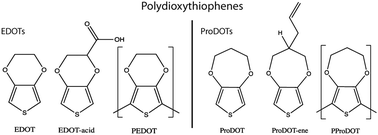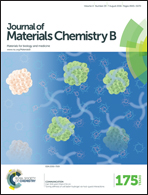Biofunctionalization of polydioxythiophene derivatives for biomedical applications
Abstract
The polydioxythiophenes PEDOT and more recently ProDOT have emerged as champion materials in the field of organic bioelectronics, both in the domain of biosensing and also for integration with living cells (both in vitro and in vivo). Although polydioxythiophenes in their pristine forms have shown great promise for bioelectronics, in order to broaden the spectrum of applications, a biofunctionalization step is essential. In this review we summarise the methods that have been used thus far to biofunctionalize polydioxythiophenes in an effort to improve the biotic/abiotic interface. We provide an introduction to this class of materials, focusing particularly on the different methods of synthesis (chemical oxidative polymerization, vapor phase polymerization or direct electrochemical polymerization) and discuss the implications of synthesis on biofunctionalization. Rather than provide an exhaustive review, we chose to highlight key examples of biofunctionalization techniques for polydioxythiophenes for specific biomedical applications. Finally, we conclude with a brief discussion of the importance of biofunctionalization methods in future bioelectronics applications, and some ideas for future directions in this field.


 Please wait while we load your content...
Please wait while we load your content...